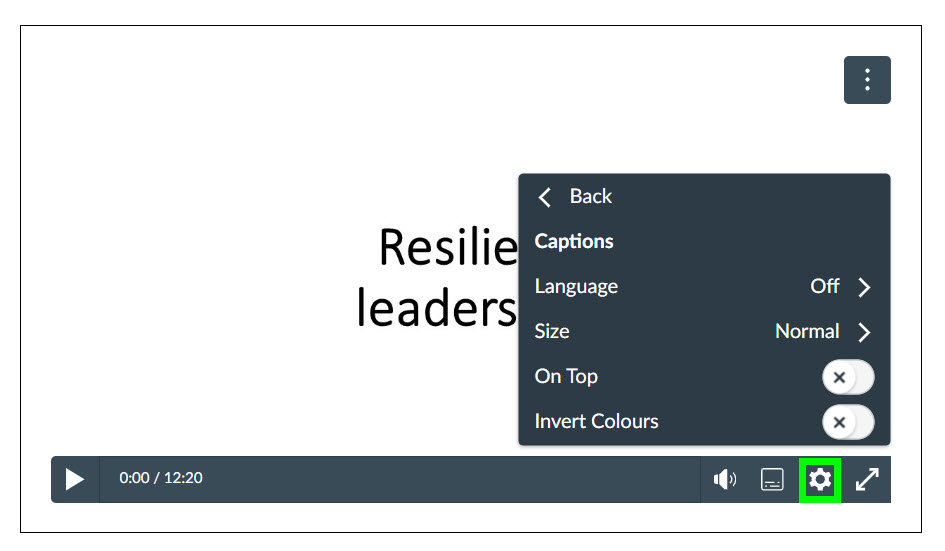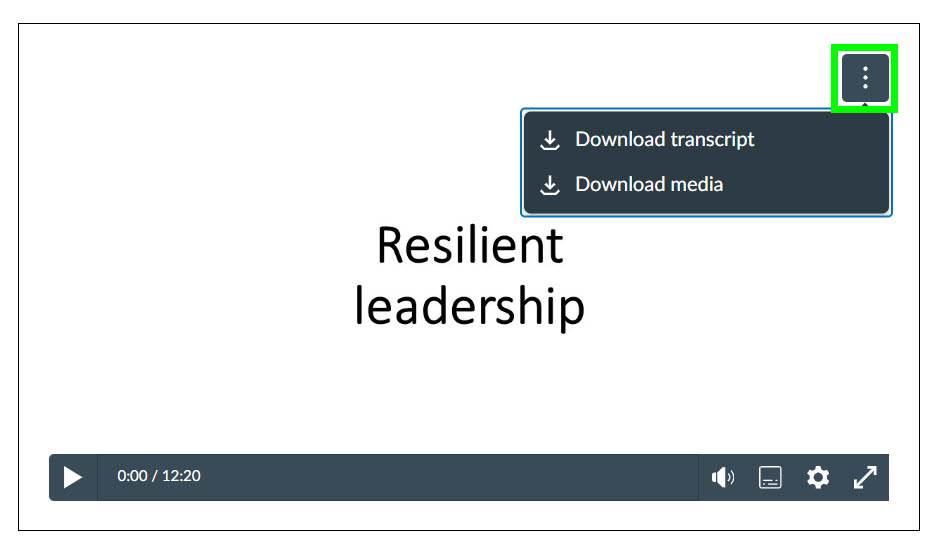Griffith University is committed to designing a digital environment that ensures accessibility for all. Below is a quick guide to accessibility features available in Learning@Griffith (Canvas).
Navigating Canvas
Canvas is designed to make navigation easy and customisable. Find your way around Canvas by exploring the navigation menu, customising Canvas to suit you and modifying your notification settings.
Canvas provides advice on how to navigate using a screen reader (Canvas Guides) using regions and headings.
You might also consider using keyboard shortcuts (Canvas Guides) for navigation.
Change view of Dashboard and Calendar
You can view the Dashboard as a list view, or as a summary of recent activity. To change the view:
- Go to the Dashboard tab in the left-hand Global Navigation
- Go to the 3 dots (More) button in the top right of the screen
- Select which option you want
The Calendar in Canvas shows you Due Dates across your courses. Views include Week, Month and Agenda.
Enabling the High Contrast Settings
The High Contrast User Interface (UI) enhances the colour contrast of text, buttons, and other elements so they are more distinct and easier to read in Canvas. For example, the red background of the Global Navigation menu will be changed to dark blue.
To switch on the High Contrast UI:
- Click the Account link in the left-hand Global Navigation
- Toggle the Use High Contrast UI on
The appearance will change once you go to another screen in Canvas, or refresh the tab.
Learn more with the high-contrast guide (Canvas Guides).
Enabling the Dyslexia Friendly Font Settings
The Dyslexia Friendly Font enhances the readability of text for users with dyslexia. To switch it on:
- Click the Account link in the left-hand Global Navigation
- Toggle the Use a Dyslexia Friendly Font on
The appearance will change once you go to another screen in Canvas, or refresh the tab.
Other accessibility settings you can enable
Via your User Settings, you can:
- enable underlining of links (this also underlines text in navigation menus)
- disable keyboard shortcuts, useful if there is a conflict with assistive technology.
To manage these settings:
- Go to the Account tab in the left-hand Global Navigation
- Choose Settings
- Scroll down to Feature Options
Using Microsoft Immersive Reader in Canvas
Microsoft Immersive Reader can be enabled in Canvas to allow you to have text read aloud, translate text into a choice of over 100 languages, highlight grammatical elements and modify font appearance. To use Immersive Reader, you need to enable it in your personal User Settings:
- Go to the Account tab in left-hand Global Navigation
- Choose Settings
- Scroll down to Feature Options > Microsoft Immersive Reader
- Change the setting control to Enabled
You will find an Immersive Reader button in the top right corner of the screen when you are viewing pages and assignments in your course sites.
Find out more about using Microsoft Immersive Reader in Canvas (Canvas Guides).
Accessing video captions and transcripts in Canvas
Canvas provides a video collection tool called Studio. Studio videos should have auto-captions available.
Caption toggle on and off

Change caption settings
You can change the appearance of captions via the Settings button and choosing Captions. You will then see options to turn captions on, and change the size, locations and to invert colours.

Download transcript (captions must be enabled)
If captions have been created for the video, you can download a transcript of the video. Go to the 3 dot (More) button in the top right corner of the video and choose Download transcript.
This menu might also include the option to download the video with Download media.

Accessibility in online classes and class recordings
For information on the use of captions, transcripts and other accessibility tools available for online classes and class recordings, see:
Microsoft Teams
Teams Meetings include a range of accessibility features, including settings for live auto-captions, zooming in on a presenters shared screen and reducing distractions.
If a Meeting is recorded, captions and transcript will automatically be available for the recording.
Find out more about Captions and other accessibility tools and accessing transcripts of recordings.
Class Collaborate
Live auto-captioning of Collaborate classes at Griffith is not available. If your course uses Collaborate, and you require live captions, contact Griffith's Student Disability and Accessibility (SDA) team to discuss your needs.
Auto-captioning of recordings can be manually activated, even if the session was not captioned live. Contact the SDA team if you require these to be enabled.
Find out more about Class Collaborate accessibility tools (Class Collaborate Support).
Echo360
Echo360 is another video tool used at Griffith. Find out how to access Echo360 transcripts.
Padlet
Find out more about Padlet's accessibility tools (Padlet Support). Padlet also offers auto-captioning for video and audio (Padlet Support).
Requesting reasonable adjustments
Griffith's Student Disability and Accessibility team is available to consult with students regarding strategies to support them and to address any potential obstacles that could impact their studies.
Accessibility in assessment
You can seek advice from Griffith's Student Disability and Accessibility team regarding strategies for completing assessment. These include reasonable adjustments to exam conditions, such as additional time or use of assistive technologies. Be sure to get in contact with the team before the course starts to allow time for your requirements and the exam conditions to be considered and adjustments identified.
All adjustments must be formally recommended by Student Disability and Accessibility and are based on your individual needs. These adjustments are added into individual settings in Learning@Griffith.
You may also find our Assessment FAQs page useful.
Assistive technology
Griffith provides assistive technology labs on each campus. Find out more about the assistive technology available.